751.1 Preliminary Design
Contents
- 1 751.1.1 Overview
- 2 751.1.2 Bridges/Boxes
- 2.1 751.1.2.1 End Slopes/Spill Fills
- 2.2 751.1.2.2 Wing Lengths
- 2.3 751.1.2.3 Live Load Determination
- 2.4 751.1.2.4 Skew Angle
- 2.5 751.1.2.5 Structure Type Selection
- 2.6 751.1.2.6 Box Culverts
- 2.7 751.1.2.7 Girder Type Selection
- 2.8 751.1.2.8 Longer Bridges
- 2.9 751.1.2.9 Staged Construction
- 2.10 751.1.2.10 Temporary Barriers
- 2.11 751.1.2.11 Earthquake Consideration
- 2.12 751.1.2.12 Replacing an Existing Structure
- 2.13 751.1.2.13 Temporary Bridges
- 2.14 751.1.2.14 Bridges Over Railroads
- 2.15 751.1.2.15 Historical Bridge Considerations
- 2.16 751.1.2.16 Preliminary Cost Estimate
- 2.17 751.1.2.17 Bridge Memorandums (Memos)
- 2.18 751.1.2.18 Soundings (Borings)
- 2.19 751.1.2.19 Substructure Type
- 2.20 751.1.2.20 Type of Footings
- 2.21 751.1.2.21 Types of Piling
- 2.22 751.1.2.22 Estimating the Lengths of Friction Piles
- 2.23 751.1.2.23 Drilled Shafts
- 2.24 751.1.2.24 Excavation Datum
- 2.25 751.1.2.25 Seal Courses
- 2.26 751.1.2.26 Cofferdams
- 2.27 751.1.2.27 Webs
- 2.28 751.1.2.28 Protection of Spill Slopes
- 2.29 751.1.2.29 Design Exceptions
- 2.30 751.1.2.30 Finishing Up Design Layout
- 2.31 751.1.2.31 FHWA Submittal
- 2.32 751.1.2.32 Aesthetic Enhancements
- 3 751.1.3 Overlays/Rehabs/Redecks/Widenings
- 4 751.1.4 Retaining Walls
751.1.1 Overview
751.1.1.1 Introduction
The Preliminary Design of a structure begins with the district submitting a Bridge Survey and Preliminary Geotechnical Report indicating their need for a structure, and ends with the completion of the Design Layout or TS&L submittal (type, size and location). This section is intended to be a guide for those individuals assigned the task of performing the Preliminary Design or “laying out” of a structure.
The types of structures can be broken into five categories:
- 1.) Bridge Over Water
- 2.) Bridge Over Roadway or Railroad
- 3.) Box Culvert Over Water
- 4.) Retaining Wall
- 5.) Rehabilitation or Overlay of Existing Structure
In addition to the following information, the Preliminary Design shall consider hydraulic issues where applicable.
751.1.1.2 Bridge Survey
The Preliminary Design process starts with the receipt of the Bridge Survey. The Structural Resource Manager records the receipt date in his file and then passes the Bridge Survey on to the Bridge Survey Processor. The following is a list of steps that are taken by the Bridge Survey Processor.
Assign a Bridge Number to the Structure
Use the next number in the Bridge Index. Book 1 is for bridge numbers that start with an “A” thru A9999 then with a “B” starting at B0001, while book 2 is for all other state bridge numbers. The “UIP” book is for off-system bridges. Anytime a bridge is rehabilitated or changed in any way, it will receive a new bridge number. For example, bridge no. A-1234 would become A12341 for the first rehab. And A12342 for the second rehab. Another example is that bridge no. L-123R would become L01232 for its next rehab. New timber bridges start with the letter “T” in book 2.
Enter the Bridge No. and other required information in the Bridge Survey Book.
Enter the Bridge No. in the Survey Received database – Microsoft Access (J:\Brhist\survrec.mdb) The password required to do this is available from the Office clerk.
Enter the Bridge No., survey received date and feature crossed in the Bloodhound 2000 database – Access
(T:\br-proj\bloodhound2000\bloodhound-2000.mdb).
Write Bridge No. on the plat and profile sheets as well as the cover letter from the district.
Create Job Folders
Check to see if a Correspondence File has been created. If the Correspondence File has been created, record the Bridge No. and make a Design Layout File for each structure received. If the Correspondence File has not been created, make a Correspondence File, an outer folder and a Design Layout File for each structure received. Here is the information for each type of folder/file:
| Folder Type | Required Information on Folder |
| Outer (pink label) | County, Route and Job No. |
| Correspondence | County, Route and Job No. |
| Design Layout | County, Route, Bridge No., Location and Job No. |
Also be sure to notify the Structural Resource Manager and appropriate Structural Project Manager (SPM) or Structural Liaison Engineer when a new Correspondence File is created. Include in your note Job No., County, Route, Bridge No. and the Bridge Division contact.
The Bridge Division contact is either the Structural Project Manager (SPM) or Structural Liaison Engineer.
Fill Out Bridge Survey Report (BR 105R)
If the district did not include a completed form BR 105R for the structure, one should be completed by the Bridge Division. This form is not necessary on rehabs, overlays and retaining walls.
An acknowledgement letter shall be sent to the district informing them that Bridge Division received the Bridge Survey. Include the Bridge No. and the name of the Bridge Division contact.
Locate the Structure on the County Map
Pull out the map for the county this particular structure is in, circle the location and write the Bridge No. on the map (Bridges only, not walls and culverts).
Calculate Drainage Information
For structures over streams or waterways, calculate the drainage area, length of stream, 10% elevation, 85% elevation and slope from topographic maps. Record this information on Form BR 105R in the Design Layout folder. If the district’s calculations indicate that the drainage area is less than 1.5 sq. miles, do not calculate the drainage area. The accuracy of the drainage area should be to the nearest 0.10 sq. mile for drainage areas less than 10 sq. miles and to the nearest 1.0 sq. mile for drainage areas greater than or equal to 10 sq. miles.
Process Electronic Files
If electronic files of the Bridge Survey plat and profile sheets were not included, contact the Transportation Project Manager (TPM) in the district or the Roadway Consultant to arrange for the files to be sent. Consult with the SPM or Bloodhound 2000 to determine who the district TPM is. When the electronic files are received, verify that the scale is 1”=10’ and that the necessary reference files are included. The Bridge Survey Processor may have to work with the district to correct any errors.
Final Step for Bridge Survey Processor
Once all of these steps are completed, the Bridge Survey Processor should deliver the Correspondence File, outer folder and the Design Layout Folder to the Structural Resource Manager. The Structural Resource Manager will then pass the files to the SPM. The SPM then requests the Structural Resource Manager to assign a Preliminary Designer.
751.1.1.3 Beginning Preliminary Design
Once the Preliminary Designer is assigned to a structure, they should meet with the Structural Project Manager to go over the Correspondence and Layout files to see if anything out of the ordinary has come up at Core Team Meetings prior to that date. It is important that any correspondence or calculations used in the laying out of the structure should be included in the bound portion of the Layout Folder.
The Preliminary Designer should then examine the Bridge Survey closely for any errors or omissions. Consult Section 748.6 Bridge Reports and Layouts. Pay special attention to the scales used. Make sure the district's submittal includes photographs and details of staging and/or bypasses (if applicable). Contact the district to resolve any discrepancies or questions. Look at the Bridge Survey cover letter to determine who the District Contact is.
A visit to the bridge site by the Preliminary Designer may be warranted to help determine Manning’s “n” values, examine adjacent properties, etc. If you decide to make this trip, advise the Structural Project Manager and the District Contact since they may also want to attend.
751.1.2 Bridges/Boxes
751.1.2.1 End Slopes/Spill Fills
The end slopes are determined by the Construction and Materials Division and are supplied to the Bridge Division by way of the Preliminary Geotechnical Report. If this report is not in the Correspondence file, contact the District to get a copy of it. The Bridge Division has made a commitment to the districts that we will have the bridge plans, specials and estimate completed 12 months after the date the Bridge Survey and Preliminary Geotechnical Report are received. The "12 month clock" does not start ticking until both the Bridge Survey and the Preliminary Geotechnical Report are in the Bridge Division.
When laying out a skewed structure, adjust the end slope for the skew angle. On higher skews, this will have a significant effect on the lengths of the spans. Often the slope of the spill fills will be steeper than the roadway side slopes. On a skewed structure, this makes it necessary to "warp" the slopes.
Whenever there will be a berm under any of the spans, its elevation should be such that there is a minimum of 4 feet clear between the ground line and the bottom of the girder as shown below.
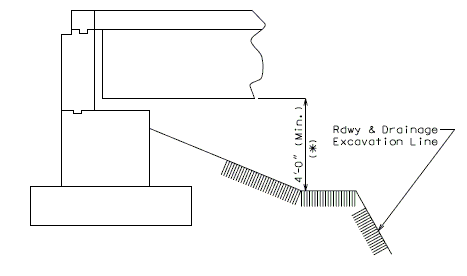
If a rock cut is encountered in the spill slope, a slope of 1:1 may be used to the top of the rock.
751.1.2.2 Wing Lengths
The lengths of the wings at the end bents are to be determined prior to the issuance of the Bridge Memorandum. There are two reasons for this. First, the district will use these lengths to determine the placement of their guardrail (bridge anchor section). Second, if the lengths of the wings exceed 22 feet, they will have to be broken into a stub wing and a detached wing wall. If this happens, then you will need to include this extra cost in your Preliminary Cost Estimate and request soundings for the wall. The request for soundings for the wall should include a request for the determination of the allowable bearing of the soil (if in cut - assume piling if it is in fill) and the angle of internal friction for the material retained by the detached wing wall. Also include the bottom of wing footing elevation.
On divided highway bridges with high skews and shallow end slopes, the wing lengths on the median side of the bridge may be less than the other side due to the difference in sideslope between the median and the outside.
751.1.2.3 Live Load Determination
The live load requirements for a structure shall be HL-93
On box culverts, the actual live load applied to the structure is dependent upon the amount of fill on top of the box; however, see Structural Project Manager for the live load that goes on the Bridge Memorandum.
751.1.2.4 Skew Angle
Determining the most appropriate skew angle for the structure involves some judgement. On bridges over streams, pick the angle that will allow floodwater to pass through the bridge opening with the least amount of interference from intermediate bent columns. Another consideration on meandering streams is to avoid a skew which will cause the spill fill – side slope transition from blocking the stream. Often a trip to the field may be justified just for determining the angle (you can even ask the district to stake some different skews for you to observe in the field).
On stream crossings, avoid skews between zero and five degrees and try to use five degree increments. On grade separations, often the skew must be accurate to the nearest second to maintain minimum horizontal clearances.
Keep all bents on a bridge parallel whenever possible and avoid skews over 55 degrees. Also keep in mind that the higher the skew, the higher the Preliminary Cost Estimate due to the beam caps and wings being longer.
751.1.2.5 Structure Type Selection
As the size of the creek/river increases, here is a rough approximation of structure type selection:
- Box Culvert (single, double or triple)
- Prestressed I-Girder (type 2, 3, 4 or 6)
- Prestressed Bulb-Tee Girder (63.5” or 72.5")
- Plate Girder
Sometimes a Solid Slab, Voided Slab, Prestressed Box Girders, Prestressed Voided Slab Beams or NU Girder bridge will need to be used instead of a Prestressed I-Girder due to limited vertical clearance or freeboard. Other times a Plate Girder or Wide Flange may need to be used instead of a Prestressed I-Girder for the same reason. Higher strength concrete girders may allow you to span further with shallower girders.
Higher strength concrete prestressed I-girders should also be considered as a means to save money by eliminating girder lines.
Prestressed concrete double-tee girders should be avoided if possible due to the redecking concerns for future maintenance.
On grade separations with high skews, you may want to consider using a 4 span bridge with integral end bents rather than a 2 span bridge with semi-deep abutments. This should be considered if the semi-deep slab length exceeds 30’.
On Prestressed I-Girder bridges, it is usually more cost effective to shorten the end spans of a 3 span Prestressed I-Girder bridge rather than having all spans the same length. The optimum span ratio is 1.1 to 1.0. For example, a span layout of (67’ - 76’ - 67’) is structurally more efficient than (70’-70’-70’).
751.1.2.6 Box Culverts
A general rule of thumb for whether or not a culvert may be used in place of a bridge is... The most a culvert can handle is about 1,000 cfs per cell with 3 cells being the usual maximum. This can vary if the slope of the streambed is unusually flat or steep. Another rule of thumb is that the water from a drainage area of less than 5 square miles can usually be handled by a concrete box culvert.
Most districts prefer a box culvert to a bridge because of the lower maintenance costs; however, if a stream crossing is on the borderline between a box culvert and a bridge, each option should be explored and presented to the district. The presentation to the district should include the cost estimate for each option as well as a recommendation as to which option is preferred by the Bridge Division. Keep in mind that box culverts should be avoided on streams with medium to heavy drift, as shown on the Bridge Survey.
Hydraulics for some small box culverts are handled by the district. For drainage areas of 1,000 acres (approx. 1.5 sq. miles or 2.5 sq. kilometers) or less, the district will do the hydraulics. For drainage areas larger than this, the Bridge Division will do the hydraulics.
If you must curve or kink your concrete box culvert, try to limit each bend to 15 degrees. The FHWA publication HDS-5 “Hydraulic Design of Highway Culverts” recommends that you space these bends a minimum of 50 feet apart. If this is not practical, you will need to account for the head loss resulting from the sharper bend.
The Final Design of box culverts (structural calculations and contract plans preparation) will be done by the Bridge Division unless it is a single cell box culvert, in which case the plans are done by the district.
When sizing the proposed concrete box culvert, use the standard cell sizes whenever possible. Consult the most recent set of Missouri Standard Plans to determine the current standard cell sizes.
Locate the inside face of the headwalls of the culvert at or beyond the edge of the roadway clear zone. It is best to confirm this with the district because they may have gotten a design exception. If the headwalls cannot be placed beyond the clear zone, common in the situation of a very low fill, then guardrail will need to be attached to the top slab at least 10” from the headwall of the culvert.
Check the Preliminary Geotechnical Report for recommendations concerning the use of collars on longer box culverts. These are called for in the Preliminary Geotechnical Report when substantial differential settlement is expected.
Do not allow the precast option on box culvert extensions or other "oddball" situations.
751.1.2.7 Girder Type Selection
Once you have determined that your structure will have girders, you must decide what types of girders to use. For checking your vertical clearance or freeboard, you will need to know the maximum span length of each type of girder. See 751.22 P/S Concrete I Girders or 751.14 Steel Superstructure. You will need to make adjustments if the span ratios get over 1.25.
Notify the District Contact as soon as you know that the profile grade will need to be raised to meet the minimum vertical clearance or freeboard requirements. If the district says the profile grade can’t be raised, consider using more girder lines, using higher strength concrete if Prestressed I-Girders or NU Girders are being used, or switching to a voided slab bridge. As a last resort, request a Design Exception for the substandard item.
Prestressed I-Girder types 2, 3 and 4 cost roughly the same per foot ($100) and even the type 6 girders cost only slightly more ($130/ft.).
If you decide to go with a Prestressed Bulb-Tee Girder, try to limit the maximum span to 125'. We have gone as far as 133' but the strands had to be at 1 1/2" centers. Also keep in mind that these types of girders are very heavy and will often require two or three cranes to set them and may be difficult to transport to the site.
If you decide to use Plate Girders, then you have to decide if the girders should be painted or not. The use of weathering steel (ASTM A709 Grades 50W and HPS70W) is preferred due to the lower maintenance costs; however, there are situations where the use of weathering steel is not advisable. Here is a brief list of times when weathering steel should NOT be used (based on FHWA Technical Advisory T5140.22):
- If the distance from Ordinary High Water to low steel is less than 8' (or 3’ between Des. High Water and low steel).
- If the bridge is located in either the St. Louis or Kansas City urban areas.
- If the bridge is over a road with an ADT greater than 10,000.
- If the bridge is over a road with an ADTT greater than 1,200.
If the vertical clearance is at least 25’, the limitations of 2.), 3.) and 4.) do not apply.
If weathering steel cannot be used, the girders should be painted gray (Federal Standard #26373). If the district doesn’t want gray, they can choose brown (Federal Standard #30045). If the district or the local municipality wants a color other than gray or brown, they must meet the requirements of Section 1045.5 Policy on Color of Structural Steel Paint. System H paint should be used on weathering steel while System G should be used on all other steel plate girders.
751.1.2.8 Longer Bridges
For bridges that are longer than normal (more than 6 spans being a general rule of thumb), other items must be considered. If the feature you are crossing allows flexibility in bent placement, the most cost efficient span length is one that will result in the cost of one span's superstructure being equal to the cost of one bent. For example, calculate the cost of one intermediate bent, and then adjust the length of the span until the cost of the girders, slab and curb equal the cost of the bent. The use of higher strength concrete in Prestressed I-Girders can allow spans to be increased 16% to 21% as a means to eliminate intermediate bents.
Another item to consider is the placement of expansion devices. Be sure to include the costs of the expansion devices and deadman anchors (if applicable) in your Preliminary Cost Estimate.
751.1.2.9 Staged Construction
If the new structure you are laying out replaces an existing structure, the exact details of the staging must be coordinated with the District Contact. If the new structure is on a new alignment, there is little cause for concern. However, if the new structure is on the same or slightly different alignment, the location of the bents for the new structure should be spaced to avoid the existing substructure units if at all possible.
Also, if the new structure is on the same or slightly different alignment, the question of traffic handling will need to be addressed. If the district wants to use a temporary bypass, then you need to determine if the district can size some drainage-diversion pipes for the bypass. If the district decides pipes cannot be used, then a temporary bridge is necessary. A separate Bridge Survey/Memo/Bridge No. is required.
If the district does not want to use a temporary bypass, and they want to maintain traffic on the existing bridge while the new one is constructed, then the new structure will have to be staged. One important item to verify in this situation is that the new girders will clear the existing substructure. Another item to consider in setting up the staging is the temporary barrier curb and required minimum horizontal distance from the edge of the deck based on whether the temporary barrier curb is attached to the slab.
751.1.2.10 Temporary Barriers
Bridge Plans must include reference to Temporary Barrier attachment if required. Coordination required with Design.
a. No attachment (Sufficient distance available to accommodate lateral deflection of barriers) b. Tie down strap system. (Refer to Standard Plan 617.20B)
Coordinate with Design to provide minimum of 4 temporary barrier sections on approach slab roadway.c. Bolt through deck system (To be used only on existing decks, with sufficient strength, that will be removed.) (Refer to Standard Plan 617.20B) Coordinate with Design for required transition barrier attachments
Lateral deflection requirements due to traffic impact on barriers must be considered if a project requires the use of Temporary Barriers. When the Temporary Barrier is used in a free standing mode immediately adjacent to the edge of a bridge deck, the distance from the edge of the bridge slab to the center of gravity of the barrier shall be 45.3 inches minimum. 45.3 inches minimum shall be used where vertical displacement of traffic at edge of pavement is a safety issue.
For all other applications of a free standing Temporary Barrier, the design lateral deflection of the barrier shall be 24 inches minimum.
Regardless of deflection distance available, if the bridge deck is super elevated or has a large roadway slope, a free standing Temporary Barrier should not be used because the barrier has the potential for movement due to gravity forces on the barrier.
When the Temporary Barrier is adequately attached to the bridge deck (Refer to Standard Plan 617.20B) minimum distance of 6 inches shall exist from the edge of the bridge slab to the face of the barrier.
751.1.2.11 Earthquake Consideration
If the structure you are laying out falls in seismic design category B, C or D, there are a few items to keep in mind. Box culverts are preferable to bridges on stream crossings because they are exempt from seismic design unless corssing a known exposed fault. Pile cap intermediate bents are preferable to open column bents on footings because footings can grow quite large due to seismic forces. Minimize the number of expansion joints in the deck because each of these locations may require earthquake restrainers which are very costly. Make the superstructure as light as possible, which usually means use steel plate girders or wide flanges instead of prestressed concrete girders where ever possible. For shorter spans, voided and solid slab bridges perform well.
751.1.2.12 Replacing an Existing Structure
If you are replacing an existing structure with a new one, you may have to calculate a cost estimate for rehabilitating the old bridge. The sufficiency rating, which can be found on the SI&A form (Structure, Inventory & Appraisal), provides information on eligibility status of the bridge for using federal bridge (HBRRP) funds:
| Status | Sufficiency Rating (SR) | Comment |
| Deficient | and SR < 50 | Qualifies for full federal bridge replacement funds. |
| Deficient | and 50 < SR < 80 | Qualifies for partial federal bridge replacement funds. |
| Not Deficient | Federal bridge replacement funds can not be used; however, other federal funds could possibly be used. |
If the sufficiency rating is greater than 50 but less than 80, then a cost analysis will need to be included in the layout folder showing that it is a better value or more cost effective to replace the bridge than it is to rehab/widen it. If rehab/widen is more cost effective, a state may elect to replace the bridge; however, federal bridge replacement funds may be capped at 80% of the rehab/widen cost estimate. See the following FHWA letter for a more detailed explanation. The SI&A form can be requested from a Bridge Inventory Analyst in the Rating Section. Include a copy of this form in the Layout Folder.
An interstate job (job no. with an “I” in it) is an example of using federal funds to replace a bridge without worrying about the sufficiency rating of the existing bridge. The reason this is acceptable is because you are using federal “interstate” funds, not federal “bridge replacement” funds.
An example of an SIA form can be seen below, followed by a letter from FHWA explaining guidelines for use of federal bridge replacement money.

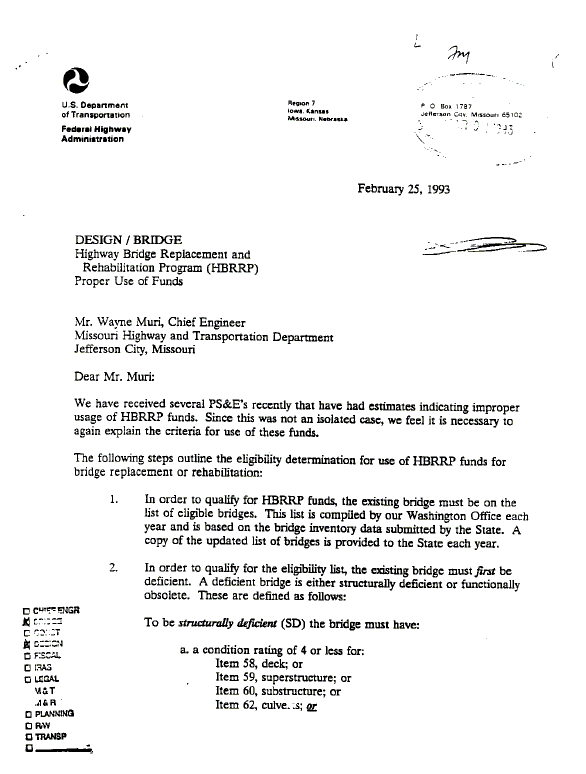

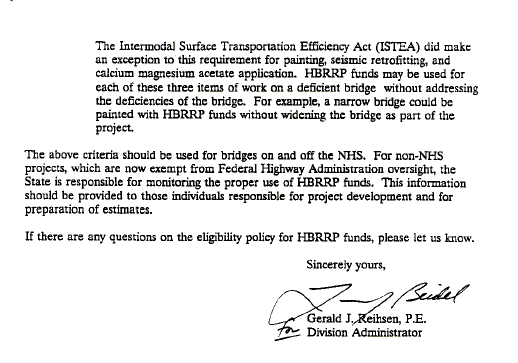
751.1.2.13 Temporary Bridges
If the district will be using a bypass on stream crossings, a temporary bridge may be necessary. The district should first consider using large drainage-diversion pipes to carry the water under the bypass, if the district determines this is not practical, they should submit a Bridge Survey for a temporary bridge on the bypass. Check with the Structural Project Manager for hydraulic design frequency.
Once the number of 40’ spans has been determined, the district should be contacted so they can locate the pieces necessary for the construction of the bridge. Make sure the pieces the district intends to use have the “new” beam caps that take 14” H-pile. The district should provide you with the location of where the pieces are coming from and where they should be taken by the contractor at the end of the project. If the district is unable to find the pieces, then they will need to be contractor furnished. This has a big impact on costs. See Preliminary Cost Estimate.
751.1.2.14 Bridges Over Railroads
Consult the AREA (American Railway Engineers Associations) Manuals located in the Development Section for more detailed information. Here are some basic points to keep in mind:
- Railroads often raise their tracks so provide some cushion in your vertical clearance.
- Horizontal clearance shall be 12'-0" plus 1.5 inches per each degree of track curvature. (MoDOT's R.R. liaison will obtain the degree of curvature from the R.R.)
- Will the railroad want room for an extra track or maintenance roadway?
- Keep the ballast free drained.
- Drainage needs to be designed for 100 year storm.
- Slope protection shall consist of 1’-6” thick rock blanket (Type 2) placed on top of permanent erosion control geotextile. Some railroads may require changes to this; however, this will be determined on a "case-by-case" basis.
- Some railroads also now require the barrier curbs and slab overhangs to be designed to accommodate fences that may be added in the future.
If the face of the columns of an intermediate bent falls within 25 feet of the centerline of the railroad track, a collision wall is required. The elevation for the top of the collision wall is set at 6 feet above top of rail.
The Railroad Liaison in the Multimodal Operations Division is a very good resource for answering questions at any stage of the layout. It typically takes a very long time to receive approval of a layout from the railroad. The Railroad has to approve both the Preliminary Design and the Final Plans!
When making a submittal to the Railroad Liaison for approval of the Preliminary Design, include three sets of half-sized plat and profile sheets, as well as a copy of the Design Layout Sheet.
751.1.2.15 Historical Bridge Considerations
You also need to check with the Historical Bridge Coordinator in the Design Division when replacing a bridge. There is not a magic age for a bridge for it to become "historical". Age does not matter. All "Bridge Resources" that will be impacted by MoDOT need to be cleared through the Department of Natural Resources (DNR) Historic Preservation Program (HPP) before they can be replaced, demolished, extensively rehabilitated or deeded to a new owner (county, city, etc.). The following is a definition of "Bridge Resources":
- "Bridge Resources are both public and privately owned highway, railroad and pedestrian bridges, viaducts and culverts. This does not include metal and plastic pipes, unless they are encased in an older concrete, stone or brick structure."
The following is the information on this topic supplied to the district (FYI):
- "Bridge Resources on any given job or location study need to be checked out and cleared just like historic buildings (architecture) and archaeological sites. Standard size color photographs can be submitted to the Historic Bridge Coordinator directly and/or attached to the Request for Environmental Assessment (RES) or Questionnaire to Determine Need for Cultural Resources Assessment. The Historic Bridge Coordinator will then determine and execute procedures for clearance, if required."
Bridges that are older than 50 years stand a better chance of being evaluated as eligible for the National Register of Historic Places (NRHP) in Clayton Fraser's 1996 draft Missouri Historic Bridge Inventory. This is a study that was undertaken under STURAA (Surface Transportation and Uniform Relocation Assistance Act of 1987) in order to inventory all potentially NRHP eligible historic bridges in the state. Any of these that are determined NRHP eligible by the HPP will require special mitigation (or avoidance) if they are to be affected by project activities. For this reason, it is important that all bridge resources be identified early in the process.
Usually, bridge resources do not stand in the way of right of way acquisition (A-dates) because they are generally located on roadways that the state already owns; however, there are cases in which bridge resources are privately owned and located on private property. In these rare cases, bridge resources would need to be checked out prior to our right of way acquisition approval.
751.1.2.16 Preliminary Cost Estimate
The Preliminary Cost Estimate should be neat, legible and dated since a copy of it is included with the Bridge Memo. It should also be rounded to the nearest thousand dollars.
The accepted method of calculating the Preliminary Cost Estimate is to actually calculate some approximate quantities for the bridge and then multiply them by the unit prices supplied by the Review Section. A spreadsheet should be used to calculate these quantities. To estimate the pounds of reinforcing steel in a structure, multiply the number of cubic yards of concrete in the structure by 125 for bridges. See table below for Box Culverts.
Box Culvert Reinforcing Steel (lbs.) Estimate Design Fill (ft.) Concrete (lbs/cy) Multiplier 2.00 225 6.00 168 10.00 116 25.00 96 32.00 84
The Preliminary Cost Estimate,should be increased for the following items: (Cost Estimate Guide for rural preliminary design )(do not compound the increases and use your judgment).
Item % Increase Staged Construction 10 Horizontally Curved 5 Seismic Performance Cat. B 10 * Seismic Performance Cat. C 25 * Seismic Performance Cat. D 40 * Tight Site/Limited Access 3
These factors assume estimated quantities have not been increased due to seismic forces.
Here are some guidelines for estimating the cost of the removal of existing bridges:
Type of Bridge Removal Cost per Square Foot Simple Structures Over Streams $ 5 Girder Structures Over Roads $ 7 Conc. Slab Structures Over Interstates $25 (quick opening of lanes to traffic)
After you calculate the Preliminary Cost Estimate, divide it by the area of the deck and compare the price per sq. ft. to this table:
The average costs vary. Usually they fall within these ranges.
Type of Bridge Avg. Price/Sq. Ft. of Deck Prestressed I-Girder $65 - $90 Prestressed Bulb-Tee $75 - $100 Plate Girder $90 - $125 Voided/Solid Slab $90 - $125 Temp. Bridge (state furn.) $25 - $45 Temp. Bridge (cont. furn.) $115 - $145 Major Lake Crossing $175 - $200 Major River Crossing $200 - $250
The cost estimate spreadsheet should be stored at T:\br-proj\current estimates after being reviewed by the Structural Project Manager
751.1.2.17 Bridge Memorandums (Memos)
The Bridge Memo is the document sent to the District that tells them where we plan to put the bridge, what kind of structure it will be, the Preliminary Cost Estimate and any other pertinent information. More information is required on more complicated structures. If you are not sure if the District needs to have a certain piece of information concerning the structure, include it on the Bridge Memo to be safe. Too much information is better than too little.
Here is a sample listing of what to include on the Bridge Memorandum:
- Identify type of structure, span lengths, skew, loading, roadway width, wing lengths and special end fill considerations. For curved structures, specify how the design span lengths are to be measured i.e., “measured along the CL of Roadway”.
- Indicate all pertinent profile grade, alignment and superelevation transition information.
- Identify the fill exception stations or ends of the bridge. The district uses this to coordinate the bridge with their roadway design features such as guardrail. For PSI-Girder bridges take into account the layout length when claculating these stations.
- Identify slopes at end bents.
- Indicate elevation of any berms to be constructed at the end bents.
- If applicable, call for old roadway fill to be removed to natural ground line.
- For box culverts, indicate the location of the headwalls and the type of wings to be provided (flared or straight). Also include the upper and lower flow line elevations along the CL of the box.
- Identify any bridge related items that the district will need to address in their plans or special provisions as a “Roadway Item”.
- Include the cost estimate for construction (Preliminary Cost Estimate). Include supporting calculations with the Bridge Memo packet sent to the district.
- Include the method of traffic handling while construction is underway. Attach sketches for staged construction when appropriate.
- For stream crossings, show all pertinent hydrologic data used for the layout of the structure. See Section 751.5.3 Hydraulics for Hydraulic Data tables.
- For grade separations, include all minimum vertical and horizontal clearances (final and construction). For bridges over railroads, also include minimum lateral clearance from the centerline of track to nearest construction falsework.
- Quite often, the district will add items to a bridge late in the final design process because they “didn’t think of them” earlier. This often causes extra work due to the necessary redesigns. Include a statement similar to the following to reduce this occurrence:
- "No conduit, lighting, utility supports or sidewalks are to be included in the final plans for this bridge."
- If the district has already indicated that they want special items attached to the bridge, include the specifics on the Bridge Memorandum and modify the above note.
- The design year ADT (average daily traffic) and ADTT (average daily truck traffic). Request this from the district if it is not shown on the plat sheet. On grade separations, get the ADT and ADTT for both roads.
- For box culverts, include the following notes:
- "Provide grading of the channel bottom with the R/W limits as needed for culvert flowline elevations and transition of the channel bed to the culvert openings. Taper channel banks to match the ends of the culvert opening as required (Roadway Item)."
- "Roadway width is ______ from outside of shoulder to outside of shoulder. The __ :1 roadway sideslopes are to be ‘rolled up and over’ the culvert to provide minimum cover on the barrel (see road plans)."
- (Use this note when the headwalls are placed to satisfy clear zone requirements and/or when the fill height on top of the culvert is very shallow resulting in a flatter sideslope than that indicated on the roadway typical section).
- Also for box culverts, state if guardrail (Roadway Item) is to be provided in lieu of meeting the clear zone requirements. If there will be guardrail over the box culvert and the fill height is less than 2 feet, indicate that attachment of the guardrail to the top slab will be handled in the bridge plans, even though the guardrail itself is a roadway item.
Once the Preliminary Designer has the Bridge Memo completed, they should submit it to the Structural Project Manager for their review. The SPM will then request a Bridge Memo Conference with the Assistant State Bridge Engineer and the Structural Resource Manager. After this review and/or conference, the Preliminary Designer will then proceed with preparing the Bridge Memo package for delivery to the district.
The Bridge Memo should be signed and dated the day you send it out. You should include spaces for two signatures from the District. When you send the Bridge Memo, you only need to send one copy on white paper. Your original signature should appear on this copy. The cover letter accompanying the Bridge Memo should be addressed to the Transportation Project Manager. A cover letter is more desirable than a Letter of Transmittal. The packet sent to the district should include a minimum of the following:
- 1 Copy of the Bridge Memo
- 1 Copy of the Calculations used for the Preliminary Cost Estimate
- 1 Copy of the Constructability Questionnaire - (modify to address project issues)
- 1 Copy of the Layout for Soundings
Once the signed Bridge Memo is received from the District, one copy should be sent to the State Design Engineer. Once again it is preferable for a cover letter to be used for this instead of a Letter of Transmittal. The reason for this is that as of December of 1998, you need to include information pertaining to floodplains in this cover letter. Specifically you need to state whether or not the bridge is in a Floodway or Zone A or other designation. You should also include a statement stating that a Floodplain Development Permit is required or that a Floodplain Development Permit is not required and that the Bridge Division will request such a permit if necessary.
The original Bridge Memo should be placed in the Layout folder upon its return from the district.
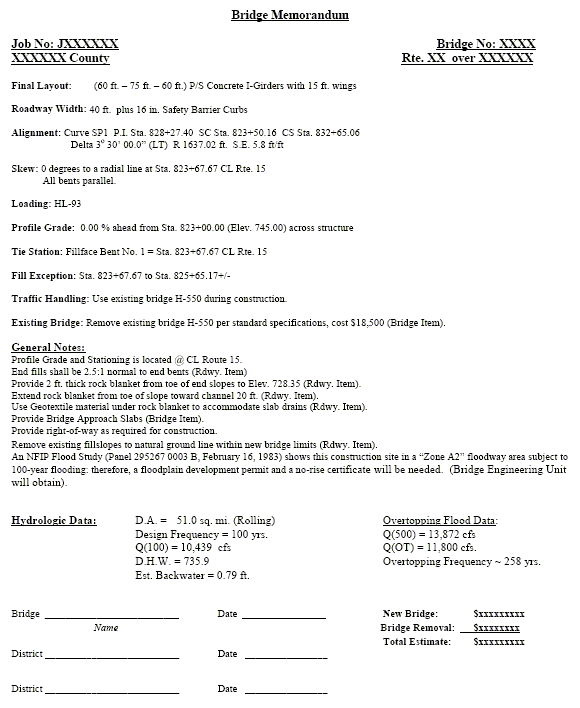

751.1.2.18 Soundings (Borings)
The purpose of the borings is to define subsurface conditions at the project site. This information will be used to determine type of foundation (driven piles, footing, spread footings), preliminary estimate of pile lengths and engineering design properties.
If boulders or cobbles are indicated, driven piles will need "shoes:, also known as pile point reinforcement.
If there is a possibility that drilled shafts will be used, request borings based on using drilled shafts so the appropriate lab work can be done the first time.
Borings should be requested at each bent. For bents on columns, estimate the number and location of the columns for each bent and request borings for these locations. Cores should be taken at each station, alternating locations at the field party’s discretion. Each boring should be taken to rock, or 30’ into material with a blow count of 20 or higher.
Completed standard forms shall be sent to the Construction and Materials Division to request soundings. This is typically done at the same time that the Bridge Memo is sent to the District. The packet sent to the district should include a minimum of the following: (Consultants should contact Structural Liaison Engineer)
- 1 Copy of the Request for Final Soundings of Structure
- 2 Copies of the Soundings Layout
- 2 Copies of the Bridge Unit Request for Soil Properties
- 2 Copies of the Plat and Profiles Sheets (half-sized)
- 2 Copies of Sheet 1A of the Existing Bridge Plans (if applicable)
In addition, an email should be sent to the Geotechnical Engineer and Geotechnical Director in Construction and Materials Division. This email should have the electronic files of the three standard forms attached.
751.1.2.19 Substructure Type
Once the signed Bridge Memo and the Borings are received, the entire layout folder should be given to the Preliminary Detailer (requested by SPM, assigned by Structural Resource Manager). The Preliminary Detailer will copy the appropriate Microstation drawings into their own directory. (Do not rename files) Consultants contact Structural Liaison Engineer. The Preliminary Detailer will then draw the proposed bridge on the plat and profile sheets and add the borings to the profile sheets. The bridge should also be drawn on the contracted profile for a perspective of the profile grade relative to the ground line for drainage considerations. The Preliminary Detailer will also generate a draft Design Layout Sheet and then return the layout folder to the Preliminary Designer for review.
The Preliminary Designer will then choose the substructure types for each of the bents. Pile cap bents are less expensive than column bents but they should not be used in the following locations;
- Where drift has been identified as a problem. *
- Where the height of the unbraced piling is excessive ( is a general rule of thumb) (take scour into account). *
- Where the bent is adjacent to traffic (grade separations).
| * Consider encasing the piling in concrete to allow a pile cap bent. |
For column bents, an economic analysis should be performed to compare drilled shafts to footings with cofferdams. When evaluating the drilled shaft option, keep in mind that if casing is used (see Geotechnical information) it should extend at least as high as the elevation that would be used for the seal course design. Also keep in mind that the permanent casing should be kept at least one foot below the ground line or low water elevation. Any casing above this elevation will be temporary.
End Bents are usually pile caps; however, if quality rock is abundant at or just below the bottom of beam elevation, a stub end bent on spread footings may be used. If you have any doubt about the suitability and uniformity of the rock, you can still use a pile cap end bent. Just include prebore to get a minimum of 10 feet of piling into the rock. If you have concerns about temperature movements, you can require that the prebore holes be oversized to allow for this movement.
Once the substructure type has been determined, re-examine your preliminary cost estimate and notify the district if it needs to be adjusted.
751.1.2.20 Type of Footings
Once it has been determined that a bent will have columns on footings, the next decision is whether the footings should be pile or spread (on shale or rock). If it is a stream crossing, the bottom of footing elevation should be based on the scour calculations found in the Hydraulic Design section. The borings should then be studied to see if a minimum of 10' of piling can be placed below the footings. If this is doubtful because of the presence of shale or rock, spread footings or drilled shafts should be used. In instances where it appears that a spread footing can be used but there are pinnacles in the area, you may want to use a pile footing and just require prebore to insure that you get the minimum embedment of 10 feet. For spread footings on grade separations, include a “not above” elevation to ensure a footing cover of at least 3 feet.
Note that two types of soundings are typically provided by a sounding investigation.
- Auger Borings - These are the most typical type of sounding provided due to availability of equipment and low cost. This type of boring is generally stopped immediately upon encountering "hard rock". All description of type of soil and rock encountered is determined in the field.
- Core Samples - These are more time consuming and expensive. They are also subject to the availability of the specialized equipment and are therefore provided as sparingly as possible by the sounding crew. Once "hard rock" is encountered at a coring location, drilling is continued for an additional 10 feet to ensure a consistent layer of actual hard rock (not a boulder). If a void layer is encountered in the additional drilling, the drilling is continued until another 10 feet of consistent hard rock is encountered. In addition to field determination of soil layer type and performance of the Standard Penetration Test (SPT), samples are returned to the lab for additional tests such as determination of rock quality (% RQD).
751.1.2.21 Types of Piling
The two types of piling commonly used are bearing pile or friction pile. Bearing pile are H-pile and are commonly used when shale or rock will be encountered at an elevation that will limit the pile lengths to about 100’. Use shoes (pile point reinforcement) if boulders or cobbles are anticipated. Prebore if necessary to achieve minimum embedment.
Here are some guidelines for minimum embedment:
Pile Type Location Minimum Embedment Steel H Pile All 10' CIP Pile End Bents 10' into natural ground CIP Pile Int. Bents 15'-20' below scour depth *
| * | 15’ If the material is hard cohesive or dense granular; 20’ if the material is soft cohesive or loose granular. |
751.1.2.22 Estimating the Lengths of Friction Piles
All designers doing preliminary design should use the DRIVEN computer program to estimate the lengths for CIP piling.
One way to check the validity of your DRIVEN results is to look at the piling information for existing bridges in the vicinity. Please also be on the lookout for any borings that contain "glacial till" (gravelly clay). This material is notorious for stopping CIP pile.
This procedure is not a substitute for experience and engineering judgment. It is simply an attempt to have a more uniform method for estimating pile lengths.
All soil data must be obtained as well as elevation information pertaining to intermediate and end bents. The soil borings and core information are then observed. The unit weights of the different soil layers are determined by correlating information from the core data with information found in reference tables. The resulting unit weights are written on the soil boring page. If the soil is cohesive, the undrained shear strength should be determined by dividing the results of the pocket penetrometer test by two. If there was no pocket penetrometer test performed, then a correlation between the SPT blow counts and the undrained shear strength can be determined from reference tables. The water table must be identified or estimated and labeled on each of the borings and cores. The water table is usually distinguishable by the presence of gray colored soil. Note that more accurate data is obtained from cores than is obtained from borings because borings are performed using an auger type apparatus that mixes and remolds the soil.
751.1.2.23 Drilled Shafts
Drilled shafts are to be used when their cost is comparable to that of large cofferdams and footings. Other examples include when there are subsurface items to avoid (culverts, utilities, etc.) or when there are extremely high soil pressures due to slope failures.
The Foundation Investigation request should include a request for opinion regarding the necessity of permanent casing when drilled shafts are investigated.
Cost estimate savings and supporting subsurface information shall be discussed with Construction and Materials before permanent casing is omitted on a project.
The borings report for drilled shafts should supply you with the allowable end bearing and side friction as well as the elevations for which the allowable rock values are applicable.
The Design Layout Sheet should include the following information:
- Top of Shaft Elevation
- Top of Permanent Casing Elevation
- Top of Sound Rock Elevation
Bent Elevation Side Friction (tsf) End Bearing (tsf)
751.1.2.24 Excavation Datum
An Excavation Datum should be placed on the Layout Sheet when water is expected to be encountered during the excavation for footings. The elevation used is usually the Low Water Elevation plus 1 foot (rounded up to the next even foot) but may be made slightly higher on bigger streams and rivers. Everything above this datum is Class 1 Excavation while everything below it is Class 2 Excavation.
751.1.2.25 Seal Courses
On structures over water with pile footings, a determination should be made as to whether or not to include seal courses. Seal courses are used in conjunction with cofferdams when a contractor may have trouble dewatering the footing excavation. They are usually necessary when you have sandy or gravelly soils and footing elevations below the stream bed. You will need to include a water surface elevation on the Design Layout Sheet for which the Seal Courses should be designed for. Typically the elevation used is the average of the Low Water Elevation and the Design High Water Elevation; however, a site visit may be required to determine how reasonable this is. In no case should this elevation be higher than the 10 year high water elevation or the overbank elevation.
751.1.2.26 Cofferdams
Cofferdams should be included if the depth of the hole for the footing exceeds 8 feet and/or the bottom of footing elevation is below the Ordinary High Water (OHW) elevation. Any bent that requires a seal course will also require a cofferdam. These are bid lump sum per bent. Consult with the Assistant State Bridge Engineer about this. All piling in pile footings should be straight (not battered) when a cofferdam is expected.
751.1.2.27 Webs
On structures over water where medium to heavy drift has been indicated on the Bridge Survey, consider using web walls between the columns on the column bents near or in the stream. The bottom elevation for the web is typically 1' higher than the overbank elevation.
751.1.2.28 Protection of Spill Slopes
The District shall be consulted for type of slope protection. Concrete Slope Protection is a Roadway Pay Item. On stream crossings, Rock Blanket is usually placed. The type and thickness of Rock Blanket is to be determined by the District based on the flow velocity from the Design High Water. This flow velocity is determined by the person doing the hydraulic calculations and should be placed on the Bridge Memo.
When Rock Blanket is used, an elevation for the upper limit of this protection needs to be calculated. First, calculate the following two elevations:
- 100 year High Water Elevation plus 2 feet
- 500 year High Water Elevation plus 1 foot
Take the higher of these two elevations and compare it to the Low Girder Elevation minus 1.2 feet. Use the lowest of these two elevations for the upper limit of your Rock Blanket. This elevation should be placed on the profile sheets.
If the toe of the abutment slope falls on the overbank, the rock blanket apron should extend from the toe toward the channel a distance equal to twice the 100 year flow depth on the overbank, but need not exceed 25 feet.
751.1.2.29 Design Exceptions
Anytime MoDOT standards are not followed, a Design Exception is necessary. These are usually initiated by the Transportation Project Manager in the district; however, if the item is related to the bridge, the Bridge Division will initiate the Design Exception.
The Design Exception Information Form should be filled out by the preliminary designer and then reviewed by the Structural Project Manager (SPM). The SPM should then submit the Design Exception to the Assistant State Bridge Engineer for review. After this review, the Design Exception should be submitted to the State Bridge Engineer for his signature. This submission should include written comments from the SPM on why the Design Exception should be approved. Once the Design Exception has been signed by the State Bridge Engineer, the SPM should mail the Design Exception Information Form and cover letter to the Transportation Project Manager in the district. The TPM will sign it and then send it to the General Headquarters Design Division for final approval. The Design Division will supply copies of the signed Design Exception to both the district and the Bridge Division.
Some examples of Design Exceptions initiated by the Bridge Division are:
Hydraulic Standards
These include not meeting the standards for freeboard, design frequency, etc.
Vertical Clearance
If the vertical clearance under a new or widened bridge does not meet the standard, a Design Exception is required. If the reduction in vertical clearance is due solely to the overlay of the road under the bridge, the Bridge Division would not initiate the Design Exception.
Roadway/Shoulder Width Less Than Standard (New Structures)
On new structures, if the roadway and/or shoulder widths on the bridge match the approach roadway, the Design Exception would be initiated by the district. If the roadway and/or shoulder widths on a new bridge are less than the approach roadway, the Design Exception would be initiated by the Bridge Division.
Roadway/Shoulder Width Less Than Standard (Existing Structures)
On Non-Interstate Rehab (3R) jobs, an exception for width is required any time we don’t meet the new design standards. The approach lanes being referred to in 3R Minimum Design Satandards (Rural) note (8) are the new lanes. The last note should be modified to read “Bridges programmed for replacement within 5 years may be allowed to remain in place as is and should be looked at on a case by case basis.”
On Interstate Rehab (4R) jobs, an exception for width is required any time we don’t meet the new design standards. If an existing bridge is over 200 feet long, FHWA has said that they will routinely approve the width if both shoulders are at least 3.5’ wide, but we should still request the Design Exception. FHWA will want to see any approved Design Exceptions before they approve the preliminary design.
751.1.2.30 Finishing Up Design Layout
Once the Preliminary Detailer has created the Design Layout Sheet and added the borings and details of the proposed bridge to the plat and profile sheets, they should be checked by the Preliminary Designer. These sheets are the end product of the Preliminary Design process and will be used to perform the structural calculations for the Final Design phase of the bridge, which results in the production of the contract plans. Here is a list of items to include.
| 1.) | General Information | |
| a. | Live load designation | |
| b. | Traffic counts for the design year (ADT and ADTT). | |
| c. | Tie station (if applicable). | |
| d. | Beginning station. | |
| e. | Horizontal curve data. | |
| f. | Profile grade information (including offset from CL of roadway or median). | |
| g. | Excavation datum. | |
| 2.) | Superstructure | |
| a. | Type and span lengths. | |
| b. | Roadway widths and type of barrier curbs. | |
| 3.) | Substructure | |
| a. | Skew(s) of all bents. | |
| b. | Types of all bents. | |
| c. | Locations of cross-bracing or webs. | |
| d. | Locations and top of wall elevations for collision walls. | |
| 4.) | End Bents (Abutments) | |
| a. | Type of end fill and maximum slope. Include earth plugs for piling in rock fill. | |
| b. | Berm elevations. | |
| c. | Type and extent of slope protection and need for geotextile material. | |
| d. | Angle of internal friction to be used for deadman anchors. | |
| 5.) | Foundations | |
| a. | Type and lengths of all piling. | |
| b. | Minimum tip elevations for friction piles. | |
| c. | Location and elevation for any preboring. | |
| d. | Location of any pile point reinforcement (shoes). | |
| e. | Types of footings, their elevations and allowable bearing (if applicable). | |
| f. | Location of any cofferdams and/or seal courses. | |
| g. | End bearing and side bearing capacity for any drilled shafts. | |
| h. | Top of Rock Socket elevations and their minimum lengths. | |
| 6.) | Traffic Handling | |
| a. | How will traffic be handled (bypass, road closure, staging, other) | |
| b. | Include a sketch of any staging. | |
| 7.) | Disposition of Existing Structure | |
| a. | Bridge No(s). of structures slated for removal. | |
| b. | Estimate cost of removal and indicate that this cost is included in the total. | |
| 8.) | Hydraulic Information | |
| a. | Drainage area and terrain description. | |
| b. | Design frequency. | |
| c. | Design discharge. | |
| d. | Design high water elevation. | |
| e. | Estimated backwater. | |
| f. | Overtopping frequency and discharge if less than 500 yr. | |
| 9.) | Miscellaneous | |
| a. | Locations of Bridge Approach Slabs. | |
| b. | Call out slab drain requirements if other than the standard procedure. | |
| c. | The location of the stationing reference line (CL roadway, CL median, other). | |
| d. | Station equations. | |
| e. | Minimum final and construction clearances (vertical and horizontal). | |
| f. | Use of weathering steel or color of paint (steel girders). | |
| g. | Name and phone number of District Contact. | |
| h. | Preliminary cost estimate. | |
| i. | Details of any utilities to be attached to the bridge. | |
| j. | Details of any conduit, light supports or any other unusual attachments. | |
| k. | Channel change requirements. | |
| l. | Temporary shoring requirements and whether it is a Bridge or Roadway Item. | |
| m. | Location of Maint. facility contractor is to use for delivery of MoDOT retained items. | |
| n. | Directory/path for any Ceal, Geopak or Microstation files used for layout of bridge. | |
Once the Preliminary Detailer and Designer are in agreement on these items, the entire layout folder should be submitted to the SPM for their review. The SPM will then request a Design Layout Conference with the Assistant State Bridge Engineer and the Structural Resource Manager.
Following this conference, the Preliminary Detailer and Designer will make any requested changes and complete the assembly of the Layout Folder by including the approved Design Layout Sheet and one set of half sized plat and profile sheets. The Layout Folder should then be delivered to the SPM along with one set of half-sized plat and profile sheets and a copy of the Design Layout Sheet.
The SPM should then use a cover letter to send the one set of half-sized plat and profile sheets, as well as the copy of the Design Layout Sheet, to the Transportation Project Manager in the district. Include in this cover letter any changes in the Preliminary Cost Estimate and the current Plans Completion Date. An example can be found on the next page.
The Preliminary Detailer should provide a copy of the Design Layout Sheet to the Bridge Survey Processor. The Bridge Survey Processor should then perform the following tasks:
- Enter the Date to Final Design in the Bridge Survey Book and the Survey Rcv. Database
- Supply a copy of the Design Layout Sheet to Development and Review.
- Copy all of the Microstation files in house to
- pwname:\\MoDOT\Documents\Central Office\Bridge\A_Prelim_design\district\job no.
- (Consultants contact Structural Liaison Engineer).
The SPM should then enter the following information into Bloodhound.
- Span layout information
- Preliminary Cost Estimate
- Date of Layout Conference
- Preliminary Plans to District
All other fields in Bloodhound should be updated at this time by the SPM.
The SPM will then send a request for a Final Designer to the Structural Resource Manager.
751.1.2.31 FHWA Submittal
Full FHWA oversight is required for the following projects:
- Interstate projects equal to or exceeding $1 million in estimated costs
- Intelligent Transportation System (ITS) projects
- Major bridge projects (over 1,000 feet long or span over 400 feet) or unique designs, operational features, unusual geotechnical or hydraulic features on the National Highway System (NHS). If the project is located off of the interstate and not sufficiently complex to warrant FHWA involvement (i.e. The project is primarily for applying a latex modified wearing surface), then FHWA oversight is not required.
For FHWA oversight, the layout needs to be submitted to FHWA for their approval. The submittal should include the following:
- Cover letter
- One set of half-sized plat and profile sheets
- One copy of Design Layout Sheet
- One copy of completed form BR105R (gray sheet)
- One copy of the Borings report including Cover Letter from Materials
- One copy of each approved Design Exception (if applicable)
- One copy of the Bridge Deck Condition Survey Summary (if applicable)
- One copy of the Bridge Rehab Checklist (if applicable)
- One copy of the Bridge Inspection Report for the existing bridge (if applicable)
- One copy of half-sized existing bridge plans (if applicable)
- One copy of anything else referred to on the Design Layout Sheet (an example would be top of pavement elevations if these are to be used in Final Design)
That is the end of the Preliminary Design phase of bridge design at MoDOT.
751.1.2.32 Aesthetic Enhancements
Aesthetic enhancements can include everything from form liners and different colored paints to actual brick or stonework on the bridge. The district is required to inform the Bridge Division if aesthetic enhancements will be required on a bridge. Aesthetic enhancements should be discussed by the core team during the scoping process.
Note: Galvanized slab drains are to remain unpainted unless otherwise requested by the district. The required special provision is available if the district wishes to paint the galvanized slab drains.
751.1.3 Overlays/Rehabs/Redecks/Widenings
751.1.3.1 Overview
Modifying existing bridges is quite different than laying out new bridges. These types of projects can be broken into four general categories:
- Overlaying an existing bridge as part of a roadway overlay project.
- Rehabilitating and/or redecking an existing bridge as a stand alone programmed project.
- Widening an existing bridge to meet minimum shoulder width requirements as part of a roadway overlay project.
- Widening an existing bridge to add lanes as part of a roadway project.
751.1.3.2 Bridges on Resurfacing Projects
This is probably the most common type of project. The first step is to determine the limits of the project. This can be done by looking at the description and log miles of the project in the Program Book. The District Contact should also be consulted to make sure the project limits have not changed. The second step is using the Bridge Maps produced by the Maintenance Division to locate any and all bridges within the limits of the project.
Once the Bridge Nos. for these structures are known, obtain a copy of the Bridge Maintenance report for each structure. These reports contain the log mile for each structure. Compare this to the log mile limits of the project. If the log mile on the report indicates the bridge is outside of the project limits, check with the District Contact again to see if the bridge is to be included in the project.
If a bridge falls within the project limits, it must be evaluated to see if it meets the current safety criteria for such items as shoulder width and curb type/height. If the job will be built with federal funds, any substandard safety item must be remedied or handled with a Design Exception. If the job will be built with 100% state funds, the bridge can be left alone (no safety improvements).
751.1.3.3 Curb Type and Height
Three types of curbs are acceptable in Missouri; Thrie Beams, Safety Barrier Curbs (SBC) and Curb and Parapets.
When using the SBC or Curb and Parapet, a five-hole bolt pattern must be used to connect the approach railing to the bridge curb.
| A) | Thrie Beam | |
| i) | If the deck is less than 8.5” thick, the attachment must bolt through the deck with a plate on the bottom side of the deck. The details showing anchoring with a bent stud formed within the deck is no longer acceptable. (The deck is too thin and the deck edge breaks off during a collision.) | |
| ii) | The center of the rail shall be 21” to the top of the finished driving surface. | |
| iii) | Thrie Beams are not a preferred railing for interstate or high ADT’s. | |
| B) | Safety Barrier Curb (SBC) | |
| i) | If installed at the time of the driving surface, the top of the curb should be no less tha 2’-8” above the driving surface. | |
| ii) | If the wearing surface is installed after the SBC is in place, the wearing surface shall be no greater than 2”, making the curb 2’-6”. | |
| C) | Curb and Parapet | |
| i) | The concrete portions of the curb and parapet are the only components that are used in calculating the height of the rail. The handrails are not crash worthy. | |
| ii) | Curb and Parapets can be as short as 2’-3” from the driving surface if no raise in grade is added. Once a wearing surface, (other than ¼” epoxy), is applied, the parapet must then be heightened to 2’-8” above the finished driving surface. This is generally done by adding curb blockouts to the existing curb and parapet. | |
| iii) | The horizontal dimension of the step from the driving face of the curb to the driving face of the parapet is recommended to be between 0” to 3” but cannot to exceed 6”. If a curb blockout is used, this dimension cannot exceed 3”. | |
| iv) | Many times the end posts are not the same width as the parapets. Check to see if the end posts are wider and if they extend towards the driving lanes or to the outside edge. It may be necessary to remove the end posts all together to accommodate for blockouts. | |
| Note: | Existing holes (For guard rail attachment) in existing bridge parapet shall be filled with an approved epoxy mortar. |
| Note: | Existing holes (For guard rail attachment) in existing bridge parapet shall be filled with an approved epoxy mortar. |
| * | Remove this area of Safety Barrier Curb for Guard Rail Attachment |
ATTACHMENT TO EXISTING CURB AND PARAPET
|
|
| * 2" (Max. Overlay) | |
| 16" SBC (2'-8") (New Curb) |
16" SBC (2'-8") (Exist. With Overlay) |
|

|
| Curb & Parapet (No Overlay) |
Curb & Parapet (Change in Grade) |
| |
| Thrie Beam (Change in Grade) | |
| ACCEPTABLE RAILS | |
751.1.3.4 Bridge Rehab Checklist
An example of a “Check List for Rehabilitation Work on Existing Bridges” is shown below.
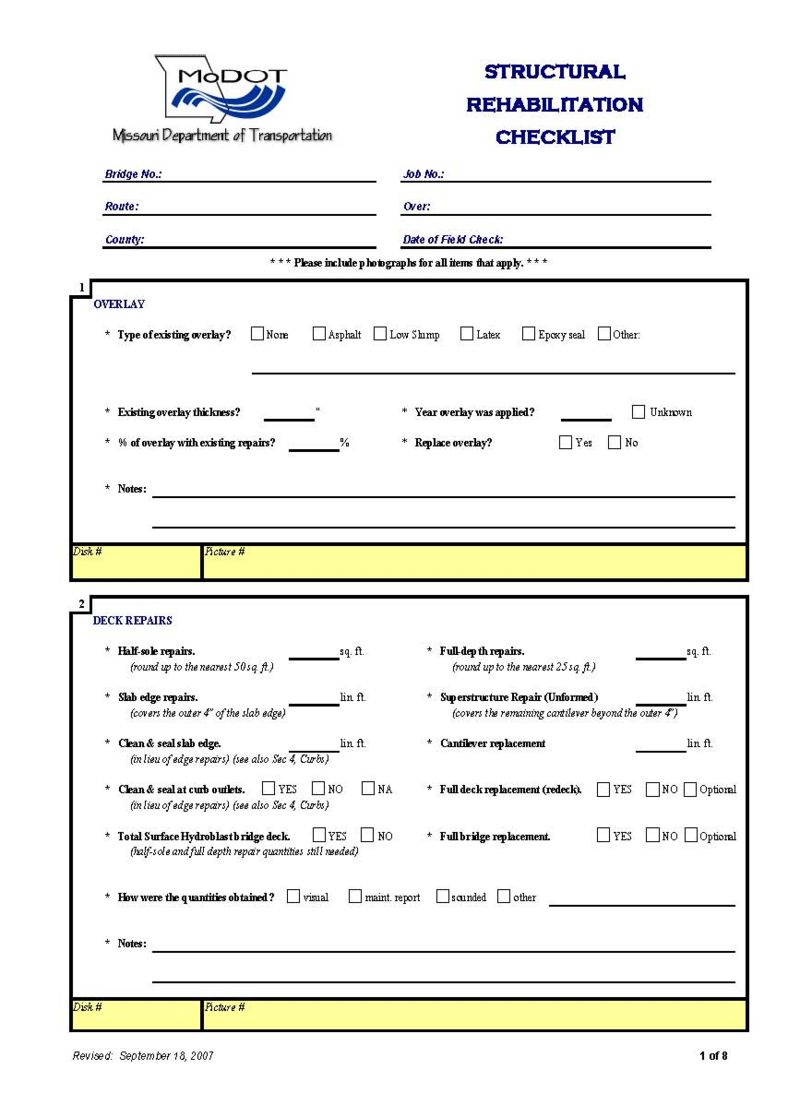
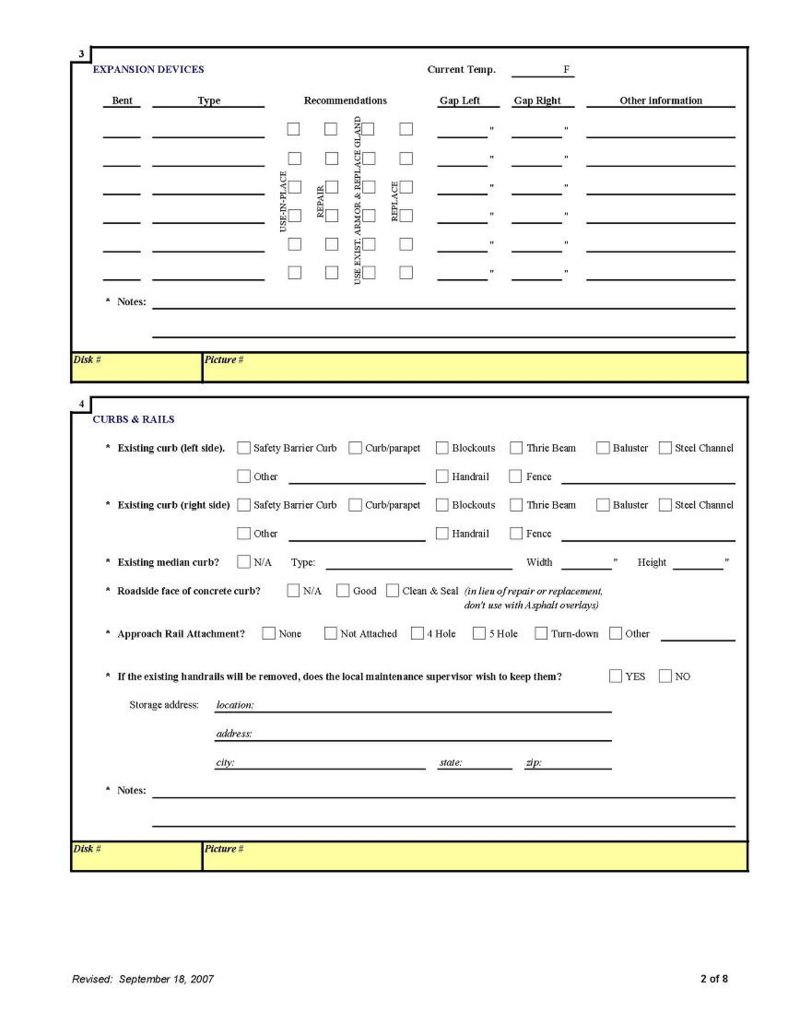
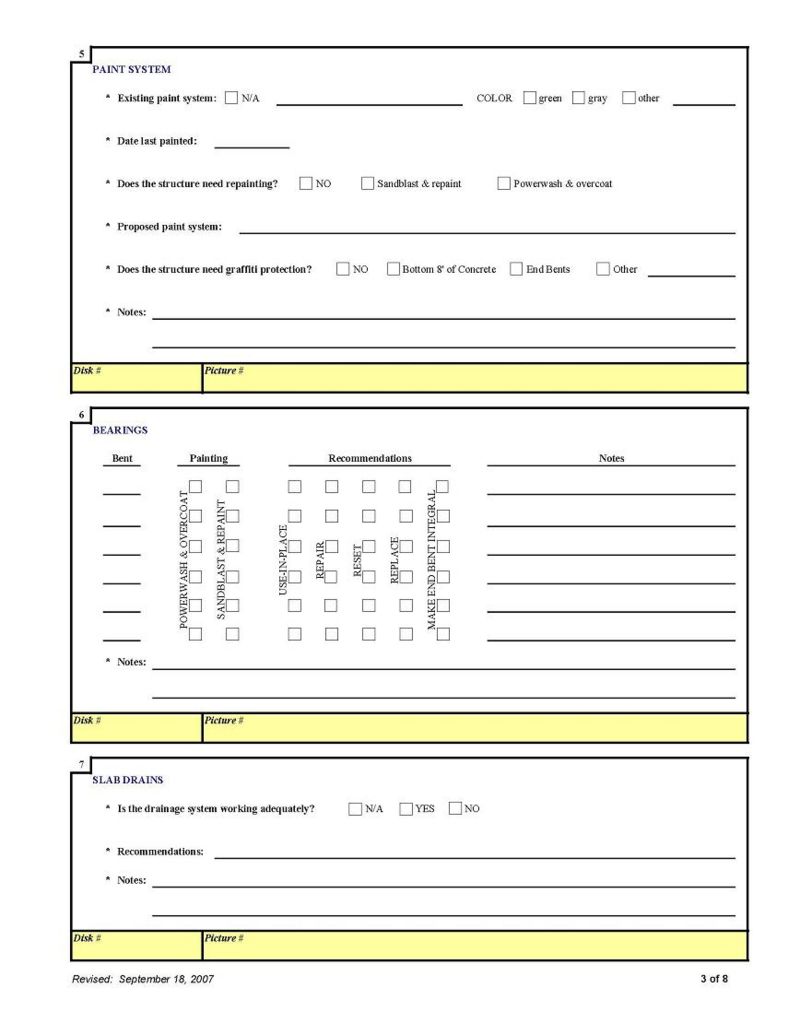
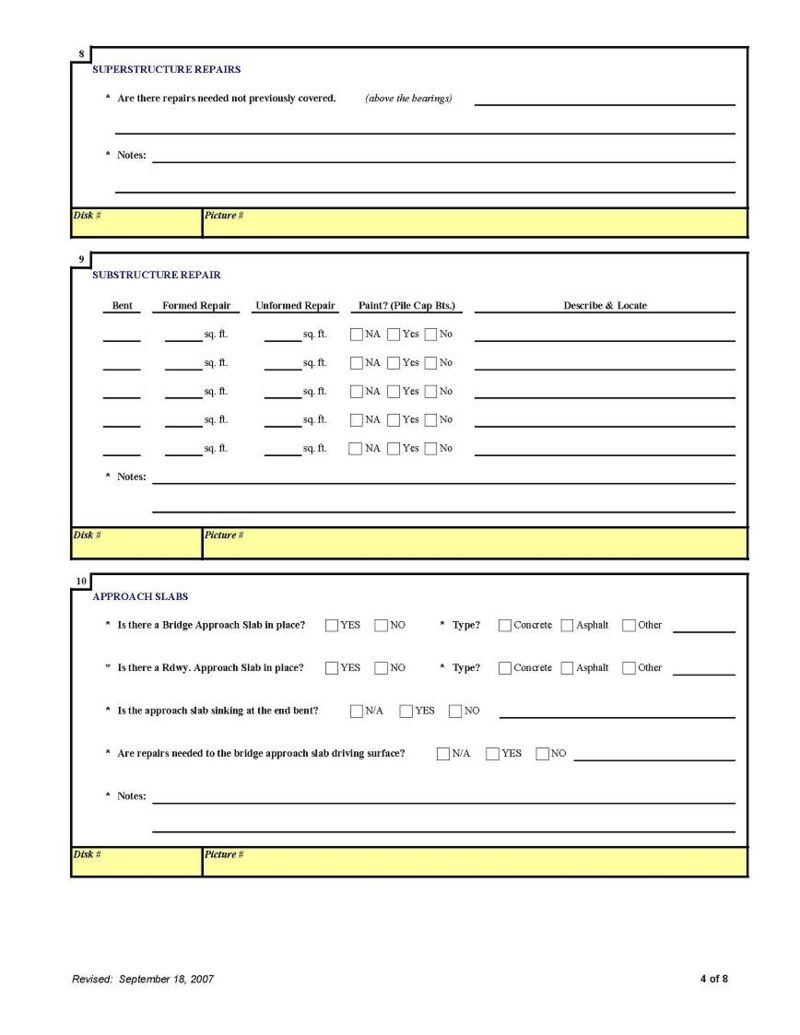
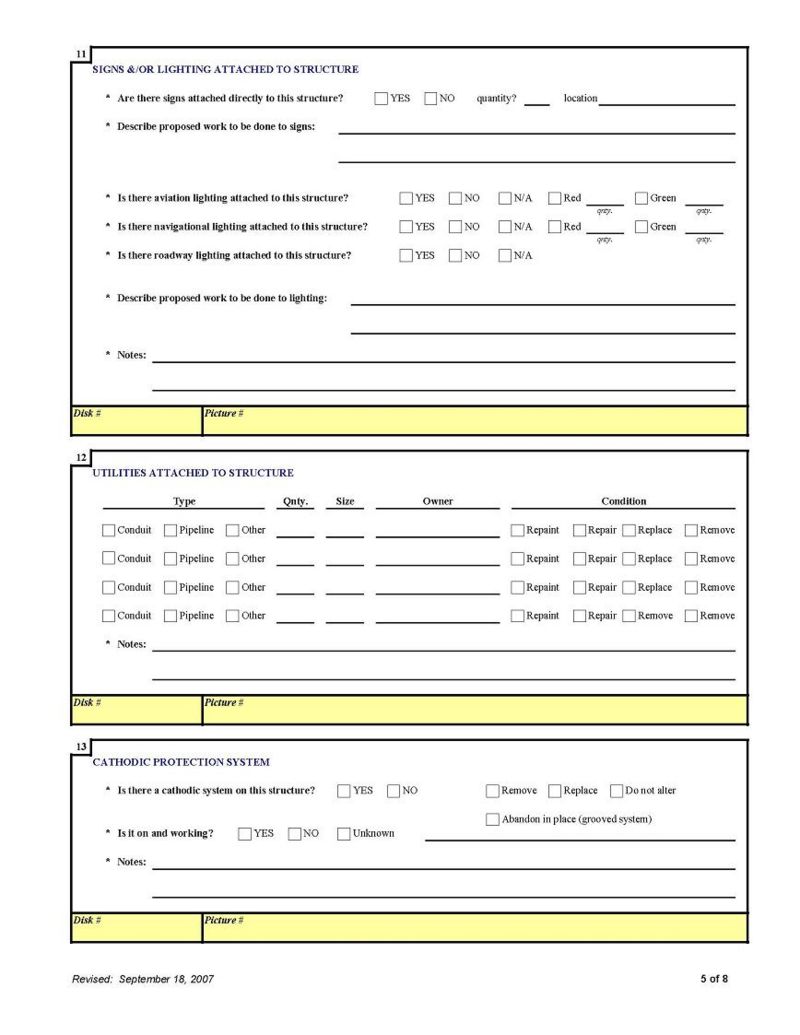
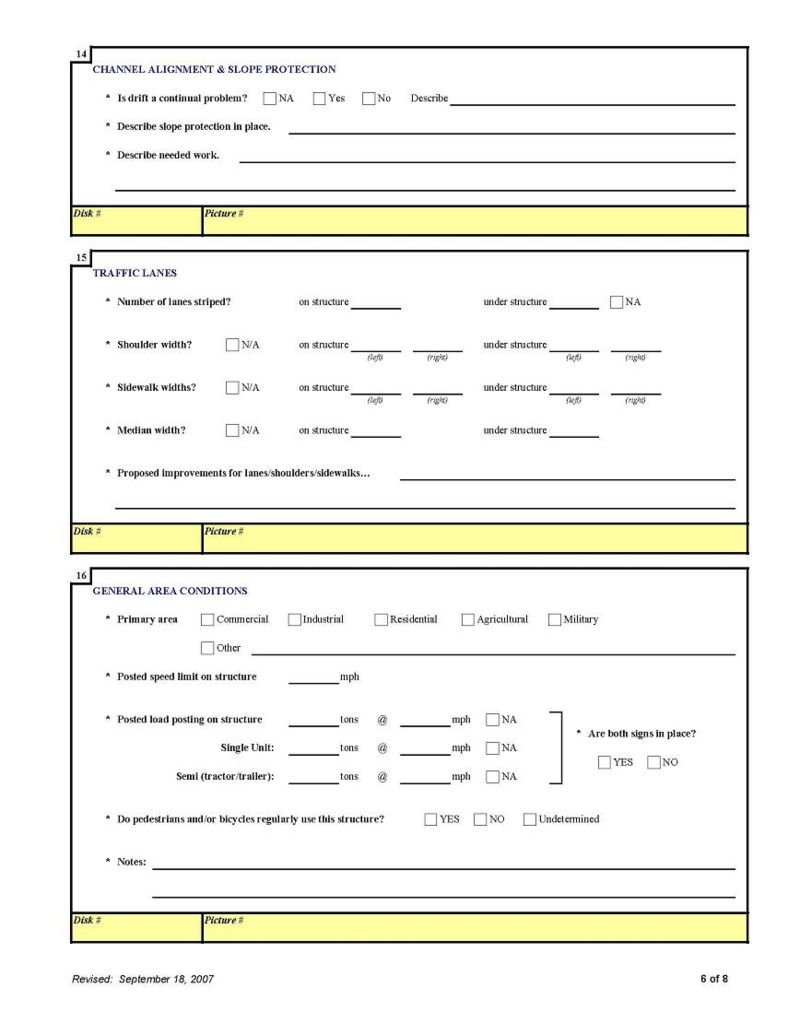
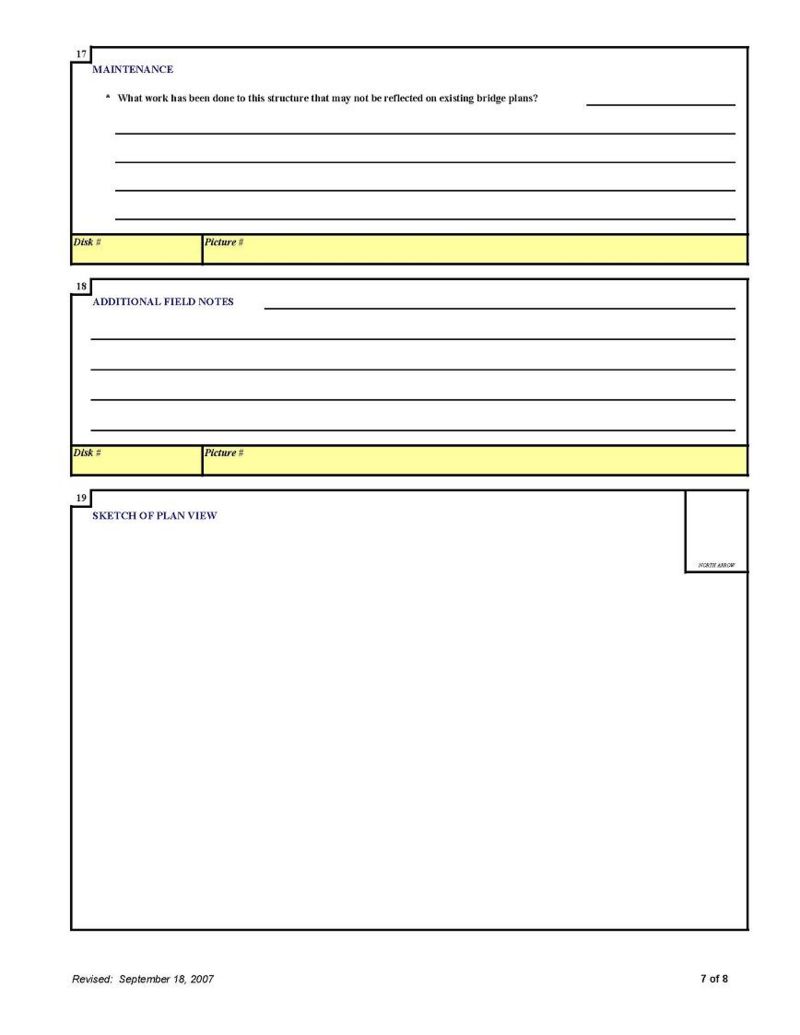
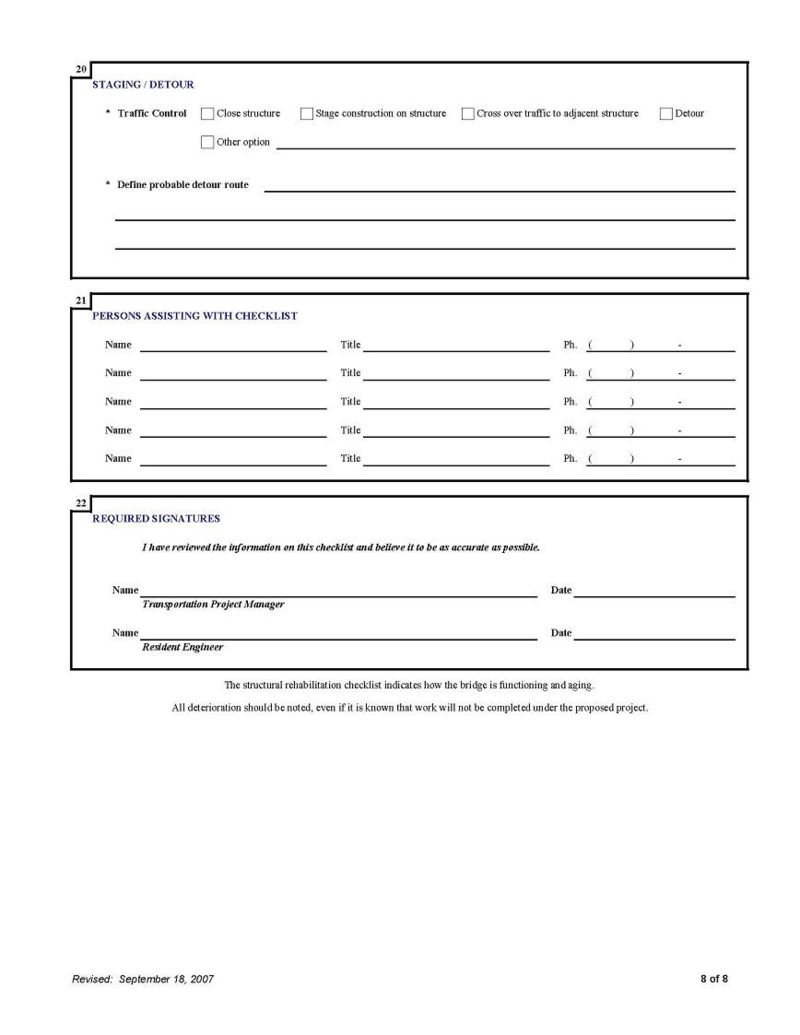
751.1.4 Retaining Walls
751.1.4.1 Overview
This section is intended to help with the issues unique to retaining walls. Many sections in the "Bridges/Boxes" section of this manual will still need to be used when working on retaining walls.
Retaining walls are very much like bridges in that they require the many of the same items, such as:
- Bridge Survey
- Bridge Number
- Bridge Memorandum
- Soundings
- Design Layout Sheet
751.1.4.2 Types of Walls
There are two general types of retaining walls used by MoDOT; cast-in-place (CIP) concrete walls and mechanically stabilized earth (MSE) walls. MSE walls are the preferred type due to their lower cost; however, there are several times when MSE walls cannot be used. These include:
- When barrier curb must be attached to the top of the wall.
- When the underlying soil cannot support the weight of the fill and wall (must use CIP on piling).
- When you don’t have adequate room behind the wall for the reinforcing straps.
In general a minimum reinforcement length of 8.0 ft. regardless of wall height, has been recommended based on historical practice, primarily due to size limitations of conventional spreading and compaction equipment. Shorter minimum reinforcement lengths, on the order of 6.0 ft. , but less than 70 percent of the wall height, can be considered if smaller compaction equipment is used, facing panel alignment can be maintained, and minimum requirements for wallexternal stability are met.
The requirement for uniform reinforcement length equal to 70 percent of the structure height has no theoretical justification, but has been the basis of many successful designs to-date. Parametric studies considering minimum acceptable soil strengths have shown that structure dimensions satisfying all of the requirements of Article 11.10.5 require length to height ratios varing gfrom 0.8H for low satructures, i.e. 10.0 ft., to 0.63 H for high structures, i.e. 40.0 ft.
Significant shortening of the reinforcement elements below the minimum recommended ratio of 0.7H may only be considered when accurate, site specific determinations of the strength of the unreinforced fill and the foundation soil have been made. Christopher et al. (1990) presents results which strongly suggest that shorter reinforcing length to height ratios. I.e. 0.5 H to 0.6 H , substantially increase horizontal deformations.
- The reinforcement length shall be uniform throughout the entire height of the wall, unless substantiating evidence is presented to indicate that variation in length is satisfactory.
- A nonuniform reinforcement length may be considered under the following circumstances:
- Lengthening of uppermost reinforcement layers to beyond 0.7H to meet pullout requirements, or to address seismic or impact loads.
- Lengthening of the lowermost reinforcement layers beyond 0.7H to meet overall (global) stability requirements based on the results of a detailed global stability analysis.
- Shortening of bottom reinforcement layers to less than 0.7H to minimize excavation requirements, provided the wall is bearing on rock or very competant foundation soil.
For walls on rock or very competent foundation soil, e.i., SPT > 50, the Bottom reinforcements may be shortened to a minimum of 0.4H with the Upper reinforcements lengthened to compensate for external stability issues in lieu of removing rock or competent soil for construction. Design Guidelines for this case are provided in FHWA Publications No. FHWA-NHI-00-043 (Elias et al. 2001).
For conditions of marginal stability, consideration must be given to ground improvement techniques to improve foundation stability, or to lengthening of reinforcement."
MSE walls are pre-qualified and listed on the internet in two categories:
- Small block walls
- Large block walls
Small block walls are battered walls with a maximum height of 10 feet.
Large block walls are vertical walls with heights that may exceed 10 feet.
Combination wall systems are considered small block wall system and shall be battered with a maximum height of 10 feet.
Any deviation from the criteria listed shall be discussed with Structural Project Manager.
751.1.4.3 MSE Walls
Both the horizontal alignment and the top of wall elevations are supplied by the district in the Bridge Survey. You do need to check the top of wall elevations to make sure the district accounted for any concrete gutters placed behind the top of the wall. These are necessary if the slope of the fill will direct water towards the top of the wall. The district should decide whether to use type A or type B gutters (Mo. Std. Plan 609.00) and where they should drain to.
You will also need to set the elevations for the top of the leveling pad. The minimum embedment, which is the distance between the finished ground line and the top of the leveling pad, is based on this table: (FHWA Demo. #82)
| Slope in Front of Wall | Minimum Embedment |
| Horizontal | H/20 |
| 3H:1V | H/10 |
| 2H:1V | H/7 |
The absolute minimum embedment is 2’. When the soundings are returned, they will include a minimum embedment necessary for global stability.
Estimating the cost of MSE walls is quite simple. Use $40 to $50 per square foot of the area of the face of the wall.
The request for soundings for MSE walls should include requests for the angle of internal frictions (Ø) for both the foundation and the retained material. Request that soundings be taken every 25 feet along the wall alignment. Soundings shall be made to rock or to a point which is 20 feet below the bottom of the wall, whichever is higher.
If soundings indicate weak material exist then the designer should investigate that sufficient right of way limits exist to address the required length for the soil reinforcement.
751.1.4.4 CIP Concrete Walls
Once you determine that you must use a CIP concrete wall, there is very little to do as far as the layout of the structure. Both the horizontal alignment and the top of wall elevations are supplied by the district in the Bridge Survey. You do need to check the top of wall elevations to make sure the district accounted for any concrete gutters placed behind the top of the wall. These are necessary if the slope of the fill will direct water towards the top of the wall. The district should decide whether to use type A or type B gutters (Mo. Std. Plan 609.00) and where they should drain to.
You will also need to set the elevations for the top of the footing, which should be a minimum of 2 feet below the finished ground line for walls south of Interstate 70 and 3 feet below the finished ground line for walls north of Interstate 70. In tight roadway situations where a barrier curb is to be placed on top of the wall, make sure that a stem thickness of 16" will fit.
Check with the District Contact to determine if they want any coping on the exposed face of the wall.
French drains will be used to relieve water pressure behind the CIP wall as a default. If you expect to encounter springs or swampy conditions, then check with the District Contact on calling for an underdrain. If the decision is made to use an underdrain, the porous backfill and pipes are Roadway Items and this must be noted on the Bridge Memorandum and Design Layout.
The request for soundings for CIP walls should include requests for the angle of internal friction (Ø) for the retained material as well as an allowable bearing value for the foundation. Request that soundings be taken every 25 feet along the wall alignment. Soundings shall be made to rock or to a point which is 20 feet below the bottom of the wall, whichever is higher.
A guide to estimating the costs of CIP retaining walls can be found on the following page. This is relatively accurate as long as you don’t need to place the wall on piling. If you have indications that the foundation material is very poor in quality (less than 1 ton per sq. foot allowable bearing), add some money for piling.
| Wall Height in Feet | Cost per Linear Foot |
| 1 | $75 |
| 2 | $125 |
| 3 | $175 |
| 4 | $250 |
| 5 | $270 |
| 6 | $300 |
| 7 | $325 |
| 8 | $350 |
| 9 | $450 |
| 10 | $575 |
| 11 | $650 |
| 12 | $780 |
| 13 | $860 |
| 14 | $1,000 |
| 15 | $1,080 |
| 16 | $1,160 |
| 17 | $1,200 |
| 18 | $1,275 |
| 19 | $1,440 |
| 20 | $1,525 |
| 21 | $1,610 |
| 22 | $1,710 |
| 23 | $1,790 |
| 24 | $1,875 |
| 25 | $1,975 |
| 26 | $2,085 |
| 27 | $2,185 |
| 28 | $2,295 |
| 29 | $2,395 |
| 30 | $2,500 |
Prices are sporadic beyond 30 feet in height.
Wall height is measured from the top of the footing to the top of the wall.
751.1.4.5 Obstructions
Any time the retaining wall will encounter obstructions, provisions must be made on the final plans. Therefore, if you are aware of any obstructions, they should be called out on the Bridge Memorandum and Design Layout Sheet. Here are some examples of types of obstructions and how to describe them on the layout:
Type of Obstruction Description Lighting Foundation Std. 45’ Light Pole, Sta. 167+48.50, 16 ft. left Sign Truss Foundation Truss T-72, Sta. 172+41.80, 31 ft. right Drop Inlet 2’ x 2’ Type D Drop Inlet, Sta. 163+12.45, 14 ft. left

